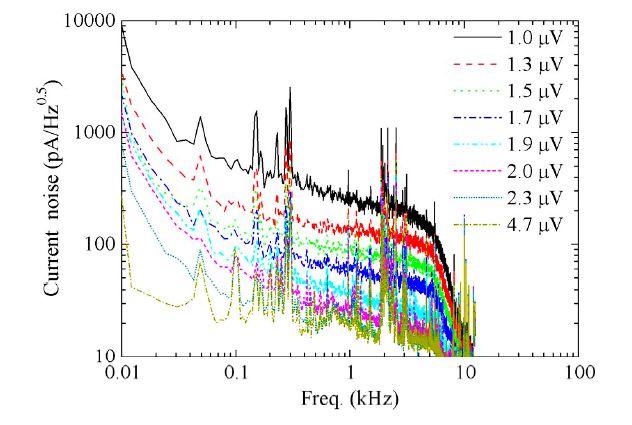Researchers led by Prof. Sheng-Cai Shi, Purple Mountain Observatory, Chinese Academy of Sciences, study the characteristics of superconducting NbSi transition-edge sensor (TES). The far-infrared/sub-millimeter band contains a wealth of information about the cold universe. Observations of gas and dust can probe the earliest stages in the formation of galaxies, stars and planets. In China, Purple Mountain Observatory is leading the efforts on a 5-m THz telescope (DATE5) to be constructed at Dome A. Its next generation will be a direct detector array with background limited sensitivity, i.e. noise equivalent power (NEP) ~10-16 W/√Hz. We are currently developing a terahertz superconducting imaging array (TeSIA) for DATE5 at 350 mm, and TES array is one potential detector candidate. 
By with ZHANG Wen Fig. Current noise spectra of the NbSi TES device at different bias voltages.
The bath temperature is 288 mK. Cut-off above 6 kHz is due to the filter in the
SQUID readout electronics. The noise at 1.3 kHz is taken as the white noise. Our superconducting TES device is based on NbSi film, which is co-evaporated on the top of a SiO/SiN/SiO trilayer on a Si substrate. Thermometers are patterned and plasma etched in a fluorine-based mixture. Niobium contacts are evaporated and covered with gold pads to allow wire-bonding. Finally the silicon wafer is completely etched by a deep reactive ion etching. We firstly measured the current-voltage characteristics at different bath temperatures from 288 mK to 440 mK, from which the thermal conductance between TES device and substrate is derived to be 345 pW/K. We then measured the current noise at different bias voltages along the I-V curve at 288 mK. The noise equivalent power (NEP) within the transition is about 8x10-17W/√Hz, which is already less than the specification of the TeSIA. An 8x3 TDM readout scheme based on SQUIDs and an ASIC is under development. Preliminary test results show that the ASIC works well at room temperature. A large TES array with background limited sensitivity is suitable for ground-based application at Dome A, Antarctica. The work by W. Zhang, J. Q. Zhong, W. Miao, W.Y. Duan, Q. J. Yao, S. C. Shi (corresponding author), J. Martino, F. Pajot, D. Prele, F. Voisin, and M. Piat, accepted by IEEE Transactions on applied superconductivity, has been published online ( http://ieeexplore.ieee.org/stamp/stamp.jsp?arnumber=6930745). |
